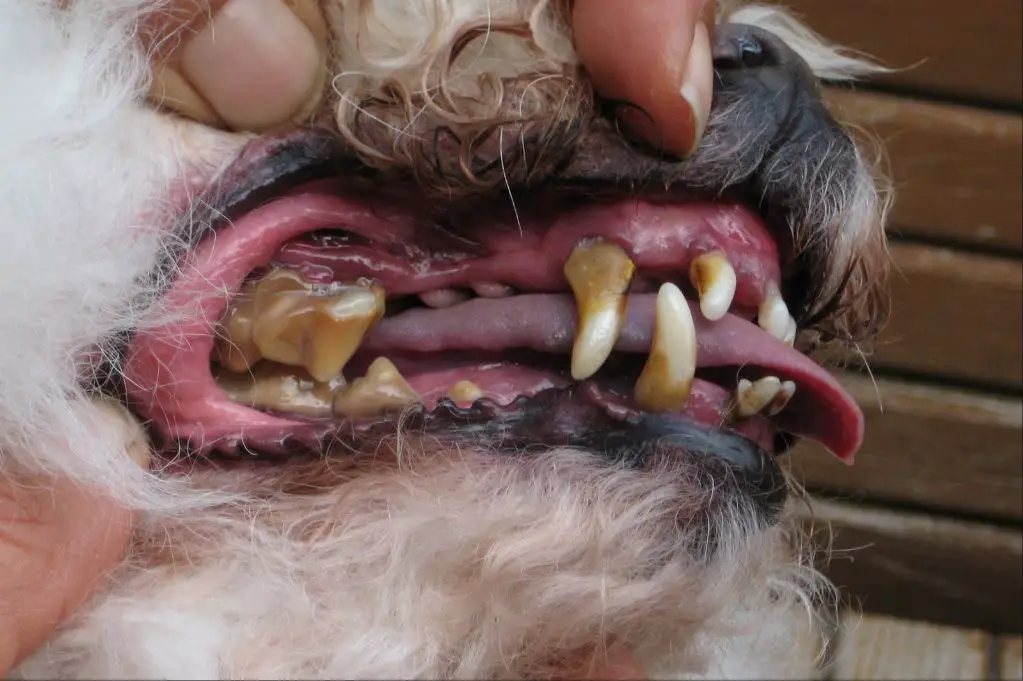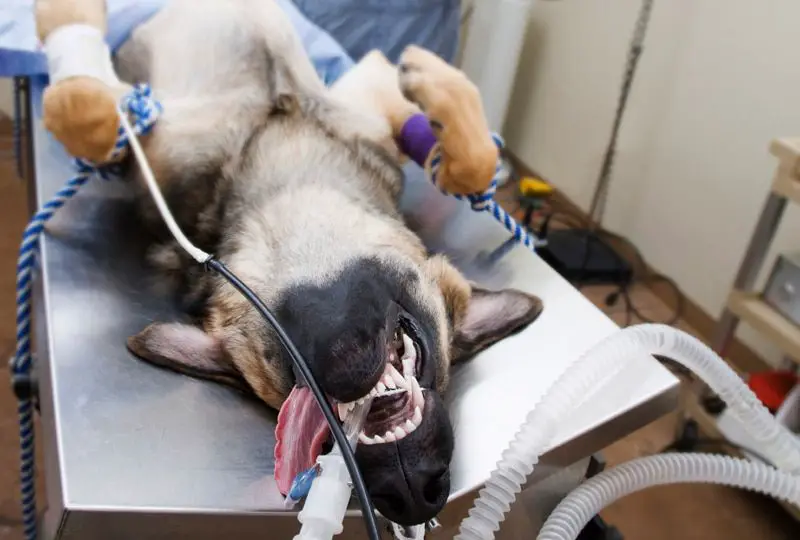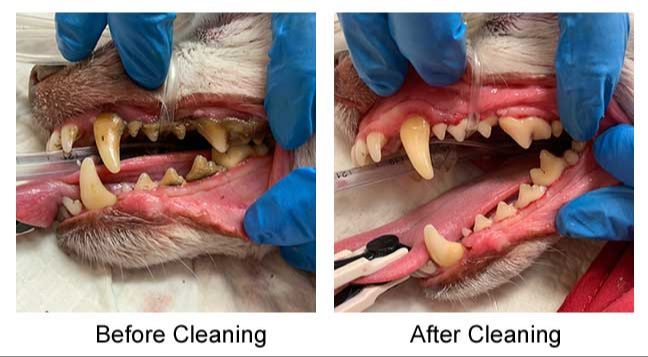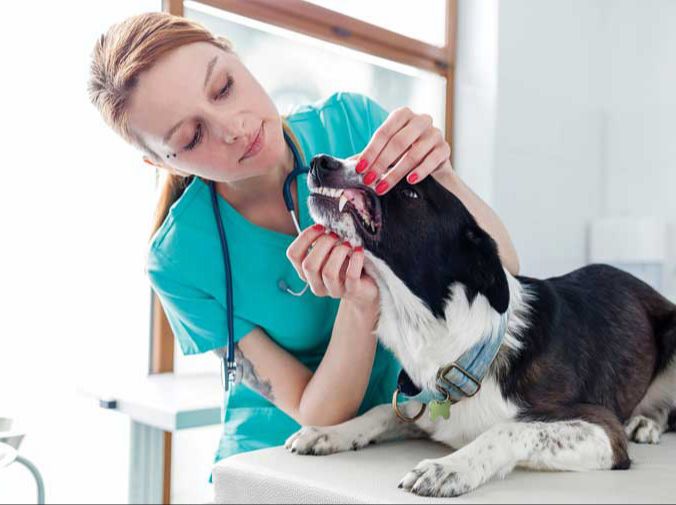Understanding Dog Dental Health
As a dog parent, it is important to understand the basics of dog dental health. Like us, dogs can develop plaque, tartar buildup, and gum disease over time. Plaque is a nearly invisible layer of bacteria that forms on the teeth. If not removed promptly, plaque hardens into tartar (also called calculus). Tartar along and below the gumline can lead to periodontal disease. This painful condition damages the gums and bones that support the teeth.
Poor dental health is very common in dogs. According to the American Veterinary Medical Association, by age 3 over 80% of dogs have some form of periodontal disease. Left untreated, it can cause tooth loss, infections, and problems with major organs like the heart, liver and kidneys. That’s why regular dental cleanings and ongoing home dental care are so critical for our canine companions.
A professional dental cleaning removes built-up tartar that can’t be eliminated by brushing. It also allows for a thorough dental exam, x-rays, and tooth extractions if needed. Keeping your dog’s teeth healthy reduces bad breath, lets them chew properly, and contributes to their overall wellbeing.
When To Get A Dental Cleaning
Deciding when to get a dental cleaning is an important part of caring for your dog’s health. Here are some signs that indicate it’s time for a cleaning along with veterinary recommendations on frequency:
Some warning signs that your dog is due for a dental cleaning include:
- Bad breath – If your dog has chronic bad breath it could indicate tartar buildup or gum disease.
- Inflamed or swollen gums – Red, puffy gums that bleed easily are a sign of gingivitis and the need for a cleaning.
- Loose or missing teeth – An unhealthy mouth will lead to tooth loss over time.
- Pawing at the mouth or face – Your dog may paw at their mouth if they are in dental discomfort.
- Discolored teeth – Yellow or brown buildup on the teeth signals tartar.
- Difficulty eating – Dental disease can make chewing painful.
Most veterinarians recommend a professional dental cleaning once a year for dogs. Some vets may advise cleanings every 6 months for small breed dogs prone to dental issues. More frequent cleanings may be needed if your dog has early stage gum disease.

It’s ideal to bring your dog in for regular dental checkups so the vet can monitor dental health and recommend when a cleaning is required. Don’t wait until you see obvious symptoms – early cleanings can prevent more severe dental disease.
What Happens During The Procedure
When your dog undergoes a dental cleaning, they will go through a multi-step process while under anesthesia to thoroughly clean, polish, and inspect their teeth. Here is an overview of what typically happens:
Pre-anesthesia bloodwork: Your vet will first take a blood sample and run tests to ensure your dog is healthy enough for anesthesia. Checking blood cell counts, liver and kidney function, and glucose levels helps minimize anesthesia risks.
Intubation and anesthesia: Your dog will be given an IV catheter and anesthesia drugs to make them fully unconscious during the procedure. An endotracheal tube is inserted into the trachea to help them breathe oxygen and anesthesia gas throughout.
Scaling and polishing: A dental scaler tool is used to clean plaque and tartar above and below the gumline. All surfaces of the teeth are polished smooth. This removes bacteria and allows a full assessment of tooth health.
Extractions: If teeth are damaged, infected, or compromised, they may need extraction. Your vet will only extract teeth necessary to protect your dog’s health.
Anesthesia Risks and Safety
Anesthesia always carries some risks, even for healthy dogs. However, modern anesthesia is very safe, especially when proper safety protocols are followed. Your vet will take steps to minimize risks and monitor your dog closely during the procedure.
The most significant risk associated with anesthesia is an adverse reaction to the anesthesia drugs. Some dogs can have allergic reactions or trouble metabolizing certain medications. Your vet will review your dog’s medical history to avoid using any drugs that are not suited for your dog’s needs.
Additional risks include low blood pressure, slow heart rate, and low oxygen levels. Your vet will monitor vitals continuously and make adjustments as needed to keep your dog stable under anesthesia. Some clinics require an attendant to be with the animal at all times and may run bloodwork beforehand as an added precaution.
The risks associated with anesthesia are relatively low, especially for younger, healthy dogs. Be sure to follow all of your vet’s pre-op instructions to minimize risks. Let your vet know of any concerns you may have so all precautions can be taken to ensure your dog tolerates anesthesia well.
Recovery And Aftercare
The recovery time for your dog after a dental cleaning will vary depending on the extent of the procedure, their age and health condition. Most dogs recover quickly and are back to normal within 24 hours. Here’s what to expect for aftercare once your dog is home:

Your dog may be sleepy and lethargic immediately after the procedure. Allow them to rest and limit activity for the first day. You’ll likely need to avoid heavy exercise for at least a week. Feed your dog a soft diet for a few days until their mouth feels better.
Your vet may prescribe pain medication to keep your dog comfortable as their mouth heals. Be sure to give all medications as directed. Watch for any concerning symptoms like loss of appetite, vomiting or swelling and contact your vet if needed.
It’s crucial to follow your vet’s at-home care instructions carefully after a dental cleaning. This includes brushing your dog’s teeth daily with a pet-safe toothpaste. Your vet may recommend a dental rinse as well. Follow any dietary recommendations, which often involve feeding dental health treats and kibble to help prevent future plaque buildup.
Schedule a follow-up appointment with your vet within a few weeks of the procedure to ensure your dog’s mouth is healing properly. Your vet will examine their teeth and let you know if any further dental work is needed.
With proper at-home dental care after your dog’s cleaning, you can help prevent the need for frequent dental procedures. But be sure to watch for signs of dental disease and schedule regular vet checkups.
Cost And Insurance
Dental cleanings and extractions can be costly procedures. The typical cost for just a basic teeth cleaning ranges from $200 to $600 or more, depending on your location and the veterinary clinic. Extractions and other treatments like sealants, fillings, or root canals will add to this cost anywhere from $500 to $1,000 or more per tooth depending on the severity.
Pet insurance can help cover a portion of these costs, typically 70% to 90% after you meet your annual deductible. Just make sure your policy includes dental illness coverage, as it is usually an optional add-on. Some pet insurance providers to consider are ASPCA, Embrace, Healthy Paws, and Trupanion. Review your options to find the best deal based on reimbursement rate, annual limit, deductible, and premium costs. You’ll likely need to pay your vet upfront and then file a claim with the insurer to be reimbursed.
Prevention At Home
There are many steps you can take at home to keep your dog’s teeth healthy and prevent the need for frequent dental cleanings.
Brushing Teeth
Brushing your dog’s teeth daily is the most effective way to remove plaque and tartar buildup. Use a soft bristle toothbrush and dog-safe toothpaste. Lift their lips to expose the teeth and gently brush in circles to cover all surfaces. Make it a positive experience with praise and rewards.
Dental Treats and Chews
Giving your dog dental chews and treats can also help scrape away tartar and plaque. Look for products with the VOHC seal that are proven to be effective. Hard chews like antlers and natural bones can also clean teeth. Supervise your dog with any chew to prevent choking.
Regular Vet Cleanings
Even with home prevention, most dogs still need professional dental cleanings at the vet every 6-12 months. Veterinary cleanings allow for dental x-rays to check for problems below the gum line and tooth extractions if necessary. Regular professional dental care is key for longevity of your dog’s oral health.
When To See A Vet
While dental cleanings help remove plaque and tartar, your dog’s teeth and gums should still be monitored afterwards for any issues. Here are some signs to watch out for that may indicate a dental problem is arising after a cleaning:
Red or Swollen Gums: Gums that appear red, inflamed or swollen could signal the return of gingivitis or other gum infection. This may occur if plaque builds up again quickly after the cleaning.
Loose or Missing Teeth: If you notice any teeth becoming loose or falling out after a dental cleaning, this indicates advanced periodontal disease. Seek veterinary help to determine next steps.

Difficulty Eating: If your dog seems to be in pain or discomfort when eating after a dental cleaning, they may have a fractured tooth or other issues. Have your vet inspect their mouth.
Bad Breath Returns: Fresh breath is a benefit of a dental cleaning. If foul odor returns soon afterwards, plaque accumulation or other problems may be recurring.
Excessive Drooling: An increase in drooling after dental work can signify mouth pain, gum injury or problems with healing.
In addition to monitoring your dog after a cleaning, continue paying attention to their dental health at all times. See your vet promptly if you ever notice discolored, cracked or chipped teeth, growths in their mouth, or other signs of disease. Early intervention can help resolve many dental issues before they escalate.
Other Dental Procedures
A dental cleaning may bring up other issues that require further procedures by your veterinarian. Some common dental procedures dogs may need include:
Tooth Extractions: If your dog has severe periodontal disease, a tooth may be loose, infected, or damaged beyond repair. Your vet may recommend extraction to remove the tooth and prevent further issues. Extractions can be simple or surgical, depending on the tooth.
Root Canal Therapy: If the pulp of your dog’s tooth becomes infected, but the tooth is otherwise healthy, a root canal can save it. This involves cleaning out the infected pulp and sealing the tooth canal.
Crown or Filling: A crown can reinforce a weakened tooth, while a filling repairs smaller cavities. These restore teeth structure and function.
Orthodontics: Braces or other devices can align crooked, crowded, or abnormal teeth. This treats bite issues and prevents further dental problems.
Discuss any recommended procedures with your vet, along with risks, recovery, and costs. With treatment, many dental issues can be repaired or managed for your dog’s comfort and health.
Finding A Vet

When looking for a vet to perform your dog’s dental cleaning, it’s important to find one with experience and proper accreditation. Here are some tips on what to look for:
Ask your potential vet these key questions:
- How many dental cleanings do you perform each month?
- Do you have dedicated staff who are trained to assist with dental procedures?
- Do you take digital dental x-rays and use dental charting?
- What kind of anesthesia do you use? Are you able to monitor blood pressure and oxygen levels?
- Do you polish the teeth after scaling them?
- Will my dog receive antibiotics and pain medication after the procedure?
You’ll want to make sure the vet is experienced, uses proper equipment and procedures, and follows up with adequate aftercare. An accredited vet will be able to answer all of these questions thoroughly.
Also look for a vet that is accredited by the American Animal Hospital Association (AAHA). AAHA hospitals undergo rigorous evaluations to ensure they meet standards for patient care, equipment, staff training, and more. Choosing an AAHA vet for your dog’s dental is a sign of a quality, trusted practice.